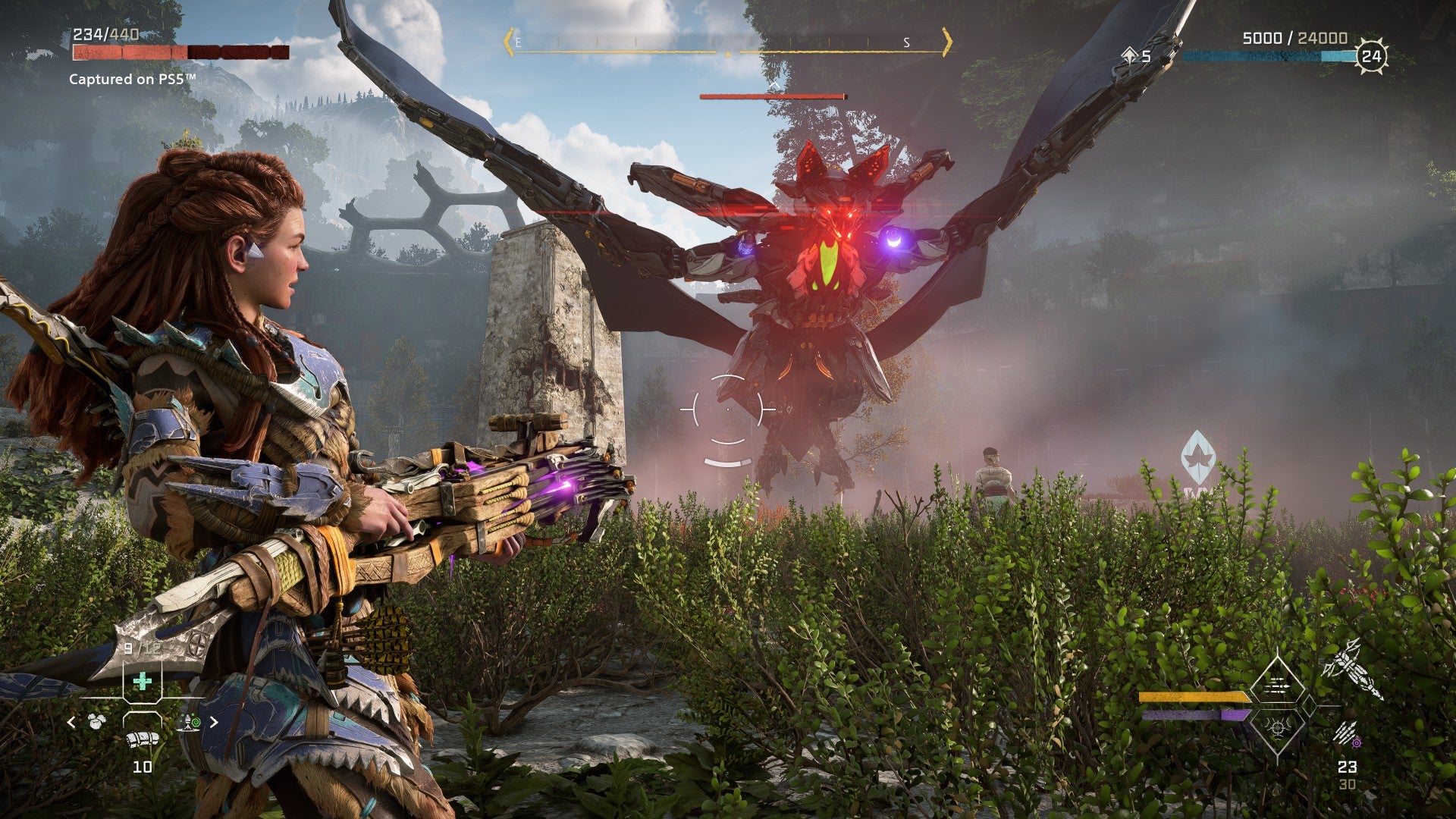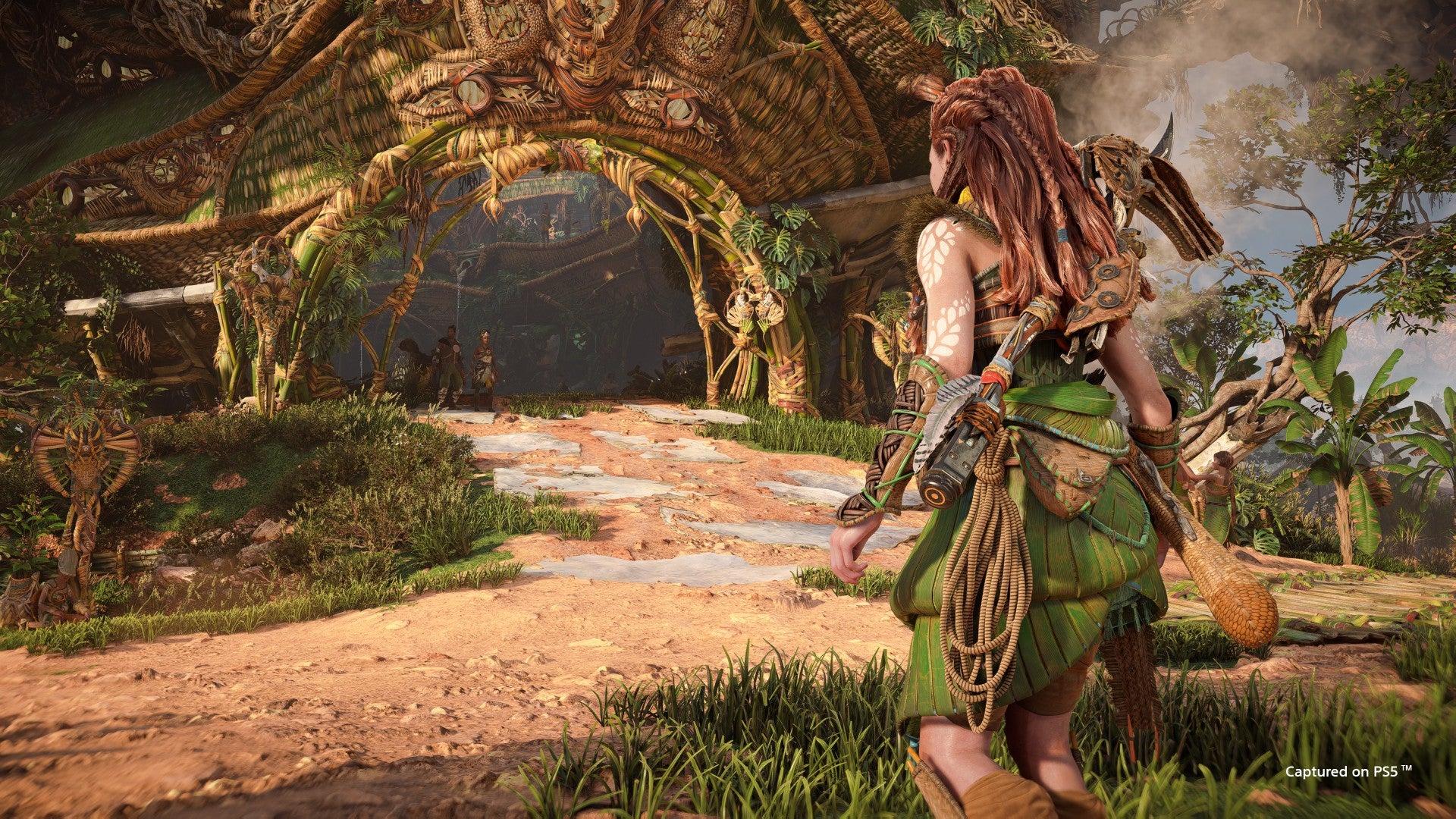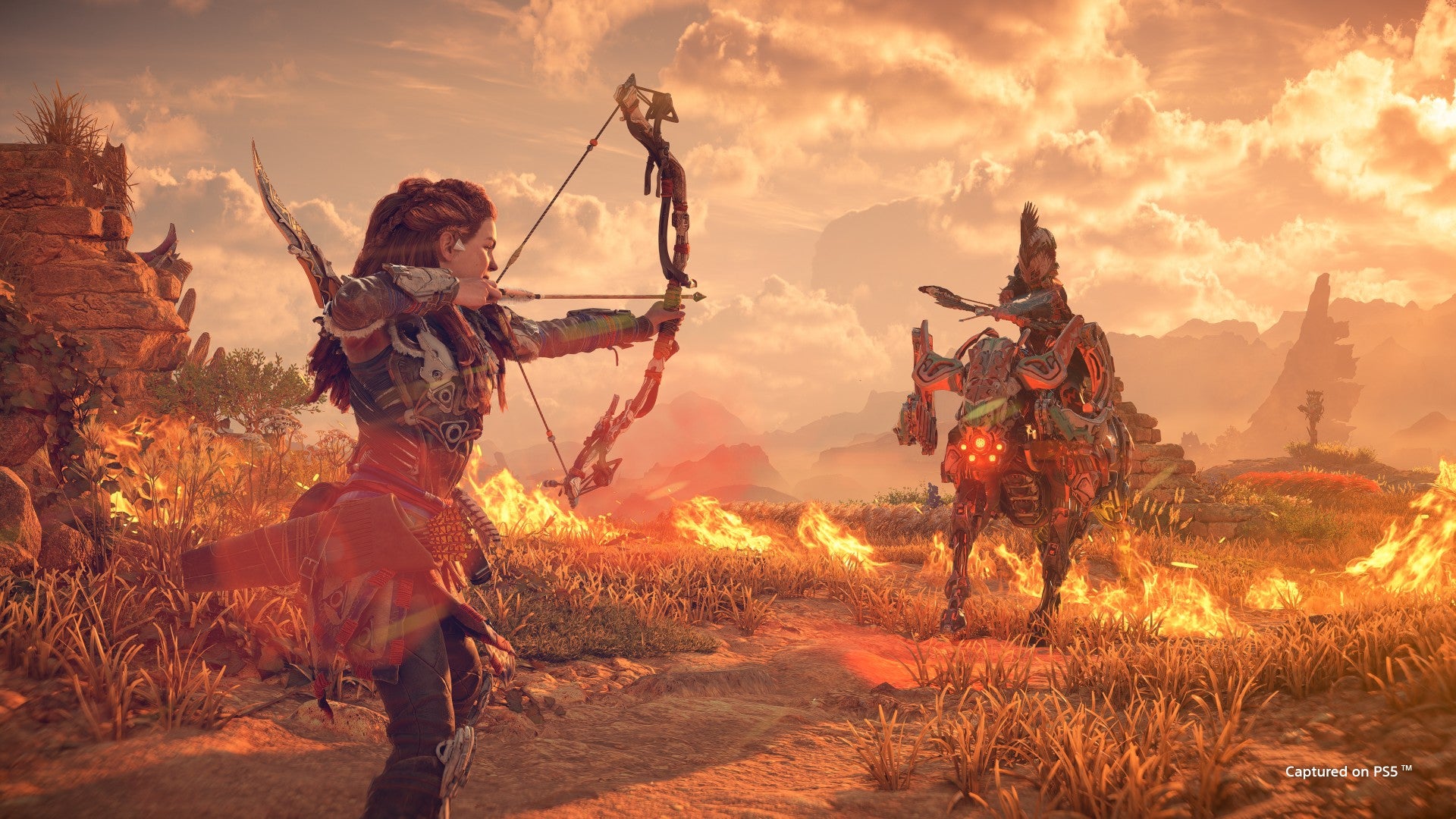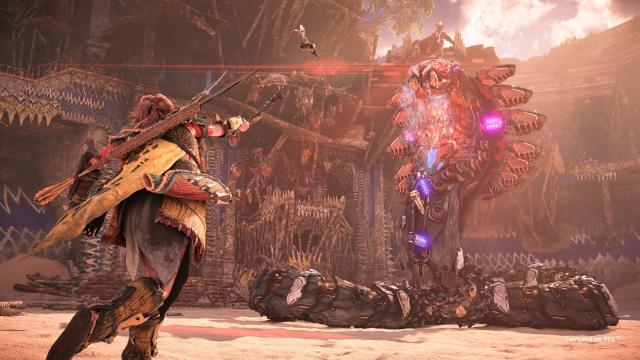It’s finally here. The day many have been awaiting for five years. The release of Horizon Forbidden West for PlayStation 4 and PlayStation 5. The sequel to 2017’s Horizon Zero Dawn, Forbidden West picks up where that story left off, as the hunter Aloy discovers that journey to save the world from evil machines was only the beginning of a much larger plot.
When I first played Horizon Zero Dawn, it took over my life. The world was so beautiful, exciting, and mysterious, all combined with perfect, intuitive gameplay, that I damn near poured 100 hours of my life into it, solving every little riddle the game had. The game literally changed how I felt about video games as a genre. So when Horizon Forbidden West was announced, I knew two things: 1) I was buying a PlayStation 5 explicitly for that, and 2) I would be playing the hell out of it.
And play the hell out of it I have. PlayStation and Guerrilla gave me a copy of the game for editorial purposes and I spent over 40 hours in the past few weeks playing. My main goal was to finish the story so I could do an interview with narrative director Ben McCaw and senior writer Annie Kitain. They’re two of the people responsible for Horizon Forbidden West’s writing and I wanted to discuss the specifics about this sequel, and also the pressures and challenges of video game writing in general. Which, as someone who largely covers film and TV, I’m admittedly naïve about.
When someone writes a movie, it’s usually one person, a computer, and their imagination. Television is similar, with the addition of a room of like-minded people around to help develop and bounce off ideas. But a video game? That’s more complicated. The story doesn’t always unfold according to plan. It’s up to the player to figure it out, especially an open-world adventure game set in a far future where humanity has once again adopted tribal customs as a species of highly advanced machine animals roam the world. Writing isn’t just writing. It’s world-building, character development, themes about nature and technology, all unfolding through the player’s eyes, no one else.
And so I dove in. and fell in love again. Horizon Forbidden West is everything I loved about the first game, just bigger and better. More weapons, better combat, cooler machines, a bigger, more sprawling game map with all sorts of incredible environments, and, most importantly, a story that ups the ante not just for Aloy, but the world of Horizon at large. Questions are answered, mysteries revealed, and the whole scope of the franchise gets dialed up to 11.
What follows below is my non-spoiler conversation about writing Horizon Forbidden West with McCaw and Kitain. What challenges a sequel provides, how the process works, what they were trying to do with Aloy’s story this time around, and more. Then, next week once the game is out, we’ll have part two where we discuss specifics and spoilers.
Germain Lussier, Gizmodo: So when Horizon Zero Dawn ends and you get the Sylens tease on there, at that point five years ago or more, how much of this story was already in progress or outlined?
Ben McCaw: Quite a bit was known. We knew it connected across the franchise and there were really quite a lot of story beats that were planned out during the development of Zero Dawn. That said, we had no idea of how people react to the game, nor did we know that we would get a sequel. So we were, of course, enormously gratified to get a chance to do this and that people really liked it. But yes, we did think of a lot of that stuff in advance
Gizmodo: The first game is, obviously, a blank slate. We don’t know who Aloy is. We don’t know when this is set. We don’t know what a Focus is or anything. But this time the rules of the world are mostly in place. You’re just expanding it out into the West. So now that the building blocks and world-building are in place, is it easier to just kind of concentrate more on the story?
McCaw: Yeah, I mean, you’re exactly right. We were trying to set up a world in the first game and we hoped we were trying to set up a franchise. And really, at the core of what that was a kind of question. I mean, I’m talking about the story, but it obviously relates to the entire game. The question is ‘How could this world possibly have this mechanical megafauna and these tribal people and this tribal Hunter Aloy?’ So the answer to that question we did not actually see being completely answered in the first game, even at that time. And it still hasn’t really 100 per cent been answered. So that was kind of like where we were coming from.
Annie Kitain: I’d also add to that for Forbidden West it allowed us to take a closer look at Aloy and her character, tell the next chapter of her story, and really start to evolve her as a character. Take what people liked about her from the first game and the mysteries that she solved and actually turn that into the pressure of now trying to live up to Elizabet’s legacy.
Gizmodo: Generally, I cover movies and television. So I know how movies and TV are written but not really games. Is it similar? Tell me a bit about writing a video game of this size.
McCaw: Sure, I mean, I think the first thing you have to understand, and I think the better comparison is to a season or multi seasoned television show, is just the sheer amount of words that are involved here. So like for Zero Dawn, we’re talking about 500,000 words minimum. And you know, depending on how you count, that could be like seven novels. So. obviously, it’s daunting. It’s a lot, but it has to be done in kind of a methodical way that’s much more similar to how you would write a television show. You are thinking of it in some episodic terms. You’re thinking about the future and you’re thinking about a whole world instead of like a kind of straight line through it, which is more like a feature film.
Kitain: One of the really fun and creative challenges of working on a game like Horizon is because it’s open-world like Ben was talking about, you have to take a methodical approach also to pay attention to in what order the player might experience some of the content, especially from the side quests. So we look at how far along in the main story they might have progressed or what other characters they might have met, or what other information they might already know. And so that’s something that we try to keep in mind and account for as you play through the content so that it feels like the world is reacting and acknowledging your experience.
Gizmodo: So there are multiple versions of side quests that change depending on how far you are into the game?
McCaw: Yes, every single side quest has conditions based on the world stage and what Aloy has done or not done.

Gizmodo: And logistically, how do the writing assignments work? Are people handed specific missions? How much collaboration was there?
McCaw: Ultimately, it’s a pretty small team. So people tend to kind of do a little bit of everything. Annie did a lot of main quest stuff. And there’s also just a huge amount of content that people don’t actually really think of as story content, sort of like the activities that you can experience in the world. So we did have different assignments and ways of breaking it up. But we also came together and worked in kind of like a writers room format as well.
Kitain: Yeah, one of the best moments was there were three of us who were working on a particular scene where we each took one of the characters and just being able to kind of bounce back and forth. We were mostly just writing that one character and those lines, but because they’re in the same room and kind of aware of each other. It was just really fun to have that back and forth. So that’s something.
Gizmodo: Last thing on the process. When do you know a story like this is over? Like, with a movie, you have to hit a runtime. A TV show has a set number of episodes. Is there a limit based on the memory of a system? How do you know when the game is as full as it can be
McCaw: It’s a great question, but it can be answered two different ways. So one of them has to simply do with the main questline. And that is a very intuitive process where you’re you’re trying to block out a story a lot like you would like a novel and you’re just trying to find those structural beats and emotional beats that make it satisfying. So then you just kind of know. But then there’s the rest of the game, which is enormous. And you know, that varies per playthrough. And that is, yeah, there’s a kind of calculus that goes on about how much content you can actually make and how much actually fits in the world. And it’s that sort of more defined that way. So the main story is the spine. And that is, that’s a highly structured, creative decision. And then everything else basically boils down to kind of filling up the world.

Gizmodo: Coming into Horizon Forbidden West, were there any big touchstones or inspirations that the team kind of looked at or aspired to either for the story of thematically?
McCaw: There’s a lot, so it’s a difficult question to answer. But I mean one of the things that are really important to us is just the natural world. So like a lot of our exploration was a visual exploration. It was a visual exploration of what the future would be like a thousand years from now without civilisation or when civilizations eroded and regrown in a certain way. We took a lot of inspiration from natural landmarks and how they might have evolved. And that’s a really, really big part of the process. In terms of thematic stuff, a lot of what we really focused on just kind of come through in the games. Mother-daughter relationships. The idea of what gets passed down through generations, even past death. And also, of course, always the world of technology and how it’s essentially a kind of double-bladed sword that if it can be deployed to destroy or it can be used to kind of regrow life.
Gizmodo: I found this game, at least the main story of it, much less about the machines than the last one. It’s about humanity on both sides, good with Aloy friends and bad with, you know, people. I can’t talk about yet. So how was that to the development of the game? Was a focus on humanity one of the touchstones of this sequel?
Kitain: Yeah, I think, there are two things that we really wanted to focus on on the story side. One was telling the next chapter in Aloy’s story and evolving her as a character, but also giving her the opportunity to deepen relationships with the MPCs of the world. So both the main companions that she meets in the main story and the side quests characters as well. So, with that in mind, we did want to really dig into what it means to live up to Elizabet’s example and as she grew up, as an outcast, having that independent streak, but also wanting to make connections with others and how that conflicts with the need to save the world by herself. So that was really a major focus for us in terms of how we approached the story.
Gizmodo: Speaking of the story, the whole point here is that what Aloy did in the first game wasn’t enough. Defeating Hades wasn’t enough. So was there ever a worry about how even making a sequel undercut the power or importance of that game?
McCaw: No, we really saw that as an advantage. Aloy ends the first game with her job half done. And she kind of knows it, and that’s kind of why she disappears from that party that night. And so we view that as like the starting point like that, that was what we thought was like a huge strength.

Gizmodo: Now this is a question, obviously you can answer with spoilers, but I’m asking you now to answer it without for now. What are you most excited for fans to discover in the story of this game?
Kitain: For me, I think, it’s seeing how Aloy changes and evolves as a consequence of the pressure that she’s under. And all the mystery that she encounters and all the new and returning friends that she meets. Just seeing how she develops of the character.
McCaw: Yeah, I mean, without going into spoilers, I would say there are certain relationships I’m particularly excited about. There’s a couple that are definitely spoilers, but yeah, but you know her relationship with Varl, her relationship with Erond, I have a particular soft spot for Alva. And then also Kotalu. I mean, maybe it’s everyone. I love everyone. But it’s how fans interact with those relationships that is so gratifying after the game comes out because people really grab on to stuff, right? I mean, like, the perfect example in the last game was Talanah. Some people just LOVED Talanah and that’s so great to watch. Those are the types of things I’m really excited about.
Gizmodo: Were there any particularly difficult story beats to break this time or discoveries you made that you were proud of in? Because obviously without spoilers, this game really expands the world in some new ways.
McCaw: I mean, I think this answer is probably not a surprise to you, but like it’s the two relationships with the two biggest spoiler characters that were the hardest thing. I mean, one of them, of course, being the one that’s sort of most important to Aloy. I mean, that was really, really difficult to conceive and write and revise and make sure we got right. No question.
As you can tell, at this point, our conversation dove into full spoilers. Check back for that next week and enjoy Horizon Forbidden West when it’s released this week.
